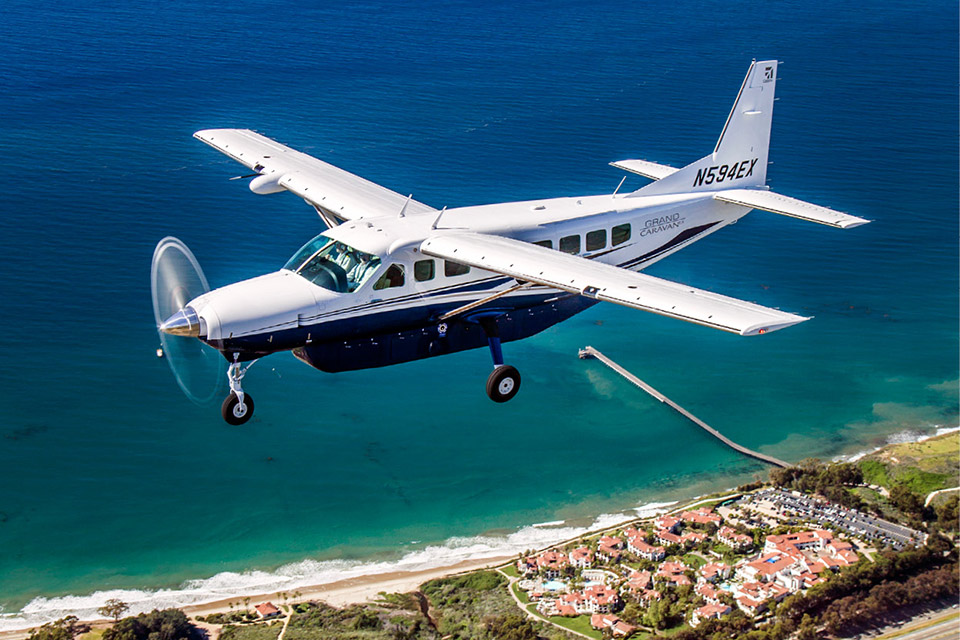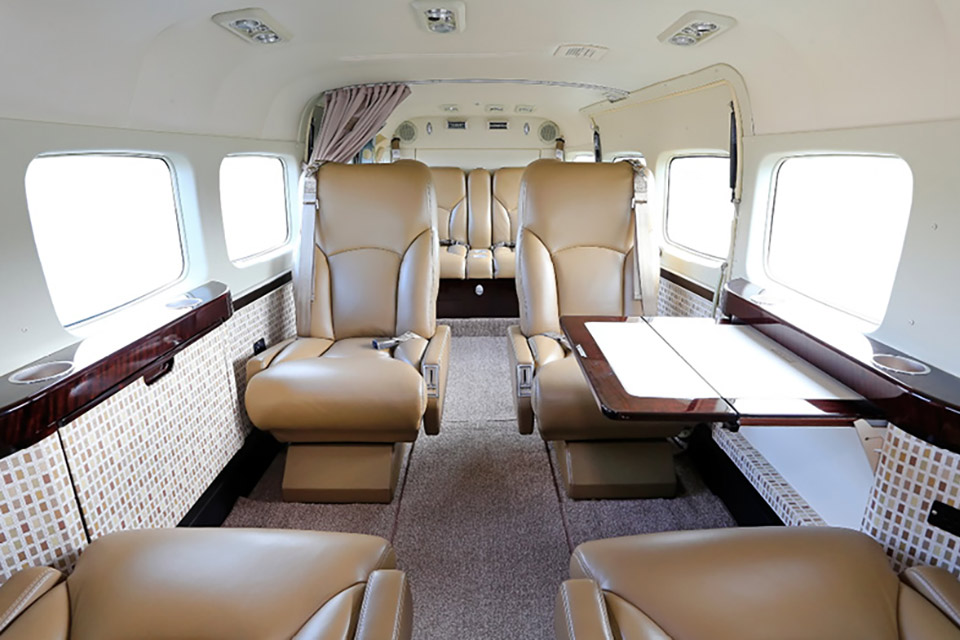Let’s take a short journey down the musty halls of general aviation history. The year is 1981, and there is much speculation. At issue is the viability of a newly hatched concept: the single-engine turboprop. “No way will anyone buy it!” most snorted, arguing that it’s too unconventional to appeal to a client base committed to the turboprop twin concept. Debates over the safety compromises of flying a single-engine turboprop droned on, but so did some ambitious design work.
The back story
Beechcraft, for one, fired up imaginations with its Model 38P Lightning project. The Lightning was a six-seater powered by a single 575-shaft-horsepower Garrett AiResearch TPE331 turboprop engine, which was mated to a Baron fuselage and a model BE36TC Bonanza’s wings. A subsequent version was powered by a Pratt & Whitney PT6A-40 turboprop engine of 550 shp. The Lightning’s first flight was in 1982, and the airplane turned in 275-knot cruise speeds. The deposits flowed in, and Beech even published a newsletter with project updates. But a recession—and Beech’s announcement of a million-dollar price tag—put the kibosh on the Lightning. Only two were ever built.
Another Baron-inspired design was Mike Smith Aero Inc.’s 280-knot Smith XP–99 Prop-Jet, powered by a PT6A-41 engine of 550 shp. But only one was ever built. A few other one-off designs were touted, but by the end of 1984 it seemed that the turboprop single idea was passé.
Or was it? While Beechcraft toiled with the Lightning, Cessna was quietly hard at work with its own idea of a turboprop single—one that wasn’t sleek and pressurized, and that could carry a lot more than six passengers. The Caravan was designed with utility in mind. And if Cessna had any initial doubts about the marketability of what looked like a Skyhawk or Stationair on steroids, it didn’t let on.
As it turned out, there was no need to worry. From the beginning, the Caravan seemed to sell itself quite well. The first Caravan was sold to an Alaskan company on February 25, 1985. But a fleet order from FedEx really got the ball rolling, and in 2015 Cessna announced the thirtieth year of Caravan production—which it celebrated with the delivery of a Caravan EX to Bering Air, an Alaska-based Part 135 operation that bought the first of its eight Caravans in 1994.
By the end of 2015 Cessna—now merged with Beechcraft under parent company Textron Aviation—expects to have delivered its 2,500th Caravan. At that time, Cessna says the Caravan fleet will have amassed more than 13 million flight hours and been certified in 100 nations. Oh, and FedEx now has a 240-strong Caravan fleet.
Behind the wheel
Flying a Caravan is a fairly straightforward proposition, especially if you already have some familiarity with Pratt & Whitney PT6A engines. Hit the starter, wait for compressor speed to come up, and then advance the condition lever to send fuel into the combustion chamber. Once interturbine temperatures stabilize, turn off the starter, turn on the Garmin G1000 avionics, do the preflight checks, and you’re ready to launch. Maybe the biggest impression during taxi and takeoff is your sight picture. You sit high off the ground—really high off the ground if you’re in a Caravan on amphibious floats. Your climb up the no-frills boarding ladder may have prepared you, but there’s nothing like being there to appreciate the lofty view.
Caravans are no slouches when it comes to takeoff performance, but short-field takeoffs are real eye-openers. Stand on the brakes, select 20 degrees of flaps, push the power lever up to just short of redline (torque will increase as speed builds during the takeoff run), release the brakes—and hang on. Raise the nose at 70 KIAS, and then climb out at 72 KIAS. The airplane levitates into a 1,000-fpm climb, which drops to 800 fpm or so as you lower the nose into an en route climb speed of 110 KIAS. Now you have better visibility over the ship’s huge nose.
As you might expect from something so large and heavy, the Caravan ailerons take some muscle when turning, and rudder and pitch trim also add to workload at first. But for the most part, the Caravan’s target numbers and flight behavior are uncannily close to those of a typical high-performance piston single: Takeoffs happen at 70 to 75 KIAS or so, cruise speeds are about 180 knots, ranges with NBAA fuel reserves hover near 800 nm, and full-flap landings call for 75 to 80 knots over the fence.
The one big difference is cruise fuel burn, which runs around 58 to 68 gph. Remember, the Caravan is unpressurized, and while an oxygen system is available, most pilots fly at piston-single altitudes. Down low, turbine engines burn fuel like mad, so that’s one of the few penalties of Caravan cruising.
Stalls? Conventional, with tons of buffeting and much stall horn racket for warnings. You say your engine quit? I once had a demo pilot simulate this by yanking the propeller to the Feather position. Once feathered, the reduction in drag was impressive. I was told that using the glide speed of 95 KIAS would make the Caravan’s glide ratio 1:14—better than a Skyhawk’s 1:9.
For instrument approaches I was taught the “10-11-12” mnemonic, which stands for 10 degrees of flaps, 1,100 foot/pounds of torque, and the resultant airspeed—120 knots. Once on the final approach course, go to 600 foot/pounds and pitch to 100 KIAS for best results. A word of warning about power technique in the flare—don’t pull the power lever to flight idle unless you are about to touch down. At flight idle the propeller blades flatten out, creating a huge amount of drag. Do that at 10 feet and you’re asking for a classic firm arrival.
Who buys ’em?
Adam Blackford, Cessna’s Caravan business leader, says Caravan sales have been averaging 90 to 95 airplanes per year for the past 15 years. Another 18 or so are fitted out for special missions and sold to foreign military forces, complete with four hard points.
Today’s basic, 675-shp Caravan accounts for 12 to 15 of total annual sales, along with about six cargo versions. The rest are the market-dominating 867-shp, 10- to 12-seat EX versions. Most EX customers have the $65,000, 1,200-pound-capacity cargo pods installed, and about eight to nine customers per year opt for Oasis-branded luxury interiors installed in Wichita by Yingling Aviation. The Oasis treatment—adding about $250,000—can have double-club seating, a DVD system, refreshment centers, and an aft potty, plus more options from a choice of up to six different floor plans. Another popular option is a single-point refueling system, priced at $45,000. Finally, Wipaire Inc. of South St. Paul, Minnesota, fits many Caravan EXs with amphibious floats (about $500,000, installed).
“Most customers think of their Caravans as family,” Blackford said. They range from ranchers in Texas to outdoorsmen fond of camping, fishing, and visiting wilderness sites, he said. Although large, heavy, and powered by a massive engine, the airplane isn’t intimidating to fly, and it has a social appeal. It makes it easy to ask a group of friends to go on a spontaneous, fun trip, for example—without worrying about how much luggage they’ll bring.
New this year
In the near future, Caravans will be equipped with new, four-blade, swept-scimitar McCauley propellers. Their blades will be two inches shorter, for better ground clearance, and the props will be 15 pounds lighter than the three-blade Hartzell propellers they’ll replace. Climb performance should be improved by 10 percent.
Also new is the Caravan EX interior. Designed in-house by Cessna, the interior will feature single- or double-club seating and new, ergonomically correct seat frames and materials. The seat coverings will be made of Luxor, a polyurethane synthetic material that looks and feels like leather but has five times the wear life, Cessna said. Thanks to these changes, the interior will be 50 pounds lighter than for previous versions.
So, has the single-engine turboprop concept been validated? No need to ask Cessna, or Caravan owners. Or a slew of other designers who have come up with their own remarkable—sometimes me-too—contributions to single-engine turboprop history. What was once unthinkable has achieved unquestioned acceptance.
Email [email protected]
SPEC SHEET
Textron/Cessna 208B Grand Caravan EX
Base price: $2.19 million
Specifications
Powerplant | Pratt & Whitney PT6A-140, 867 shp at 1,900 rpm
Recommended TBO | 3,600 hr
Propeller | Hartzell, constant speed, full feathering, reversible pitch, 3 blades, 106-inch diameter
Length | 41 ft 7 in
Height | 15 ft 1 in
Wingspan | 52 ft 1 in
Wing area | 279.4 sq ft
Wing loading | 31.49 lb/sq ft
Power loading | 10.15 lb/sq ft
Seats | 2+8/12
Cabin length | 16 ft 9 in
Cabin width | 5 ft 2 in
Cabin height | 4 ft 3 in
Basic operating weight | 5,330 lb
Max ramp weight | 8,842 lb
Max takeoff weight | 8,807 lb
Max useful load | 3,512 lb
Max payload w/full fuel | 1,266 lb
Max payload | 3,170 lb
Max landing weight | 8,500 lb
Fuel capacity | 335.6 gals/2,246 lb
Baggage capacity | 1,410 lb, 143 cu ft
Performance
Takeoff distance over 50-ft obstacle | 2,160 ft
Max rate of climb, SL | 1,275 fpm
Max cruise speed/range/fuel burn (cargo pod), 10,000 ft | 185 KTAS/792 nm/65 gph (no cargo pod),
10,000 ft | 195 KTAS/832 nm/65 gph
Max operating altitude | 25,000 ft
Service ceiling | 25,000 ft
Landing distance over 50 ft obstacle | 1,836 ft
Landing distance, ground roll | 1,004 ft
Limiting and recommended airspeeds
VX (best angle of climb) | 72 KIAS
VY (best rate of climb) | 104 KIAS
VA (design maneuvering, 8,807 lbs) | 148 KCAS
VFE 0-15 degrees flaps | 148 KCAS
15-30 degrees flaps | 125 KCAS
VMO (max operating speed) | 175 KCAS
VS1 (stall, clean) | 78 KIAS
VS0 (stall, landing configuration) | 60 KIAS
For more information
Contact Textron Aviation (cessna.txtav.com).
All specifications are based on manufacturer’s calculations. All performance figures are based on standard day, standard atmosphere, sea level, maximum weight conditions unless otherwise noted.
Extra
The TKS ice protection system is an $89,125 option.
Caravan timeline
1981 Caravan program launch
1982 First flight of Caravan 208 prototype
1984 Caravan 208 receives FAA type certification
1985 Cessna begins deliveries of the Caravan 208
1985 Caravan 208 approved for amphibious floats
1986 Caravan 208B Super Cargomaster, stretched by four feet in a freight-specific configuration, receives FAA type certification
1990 First production Grand Caravan 208B delivered
1998 Delivery of 1,000th production Caravan 208
1998 Cessna begins deliveries of new standard Caravan 208, with a Pratt & Whitney Canada PT6A-114A engine rated at 675 shaft horsepower
2002 Delivery of 1,000th Grand Caravan 208B
2003 Oasis executive interior option offered
2005 Delivery of 1,500th production Cessna 208
2008 Garmin G1000 becomes standard avionics equipment
2008 TKS ice protection offered as option
2012 Cessna and China Aviation Industry General Aircraft Company Ltd. announce joint venture with Caravan final assembly in China for the Chinese market
2013 Cessna begins deliveries of Grand Caravan EX, featuring a Pratt & Whitney Canada PT6A-140 rated at 867 shaft horsepower
2013 Grand Caravan EX Amphibian receives FAA type certification, deliveries commence










